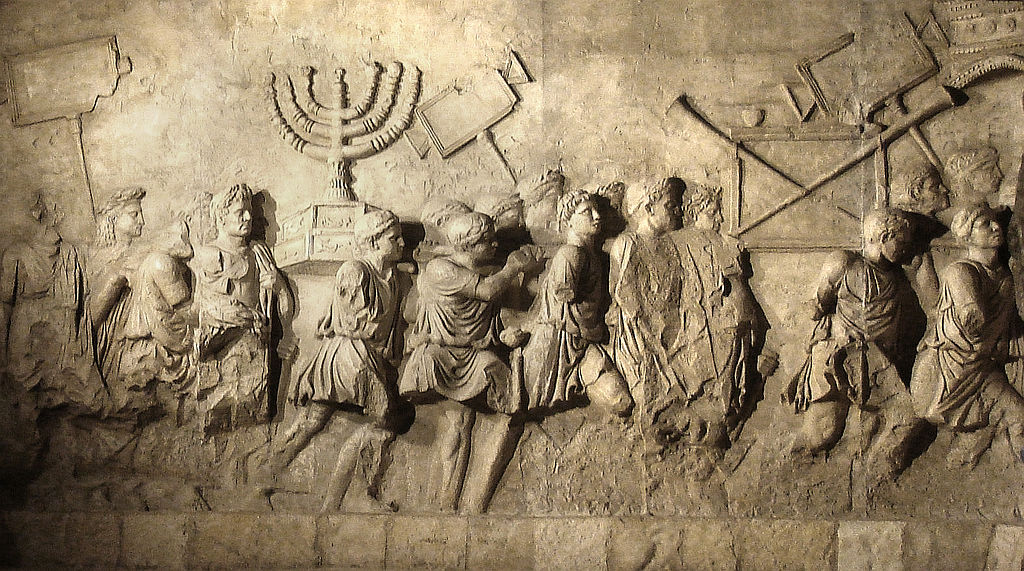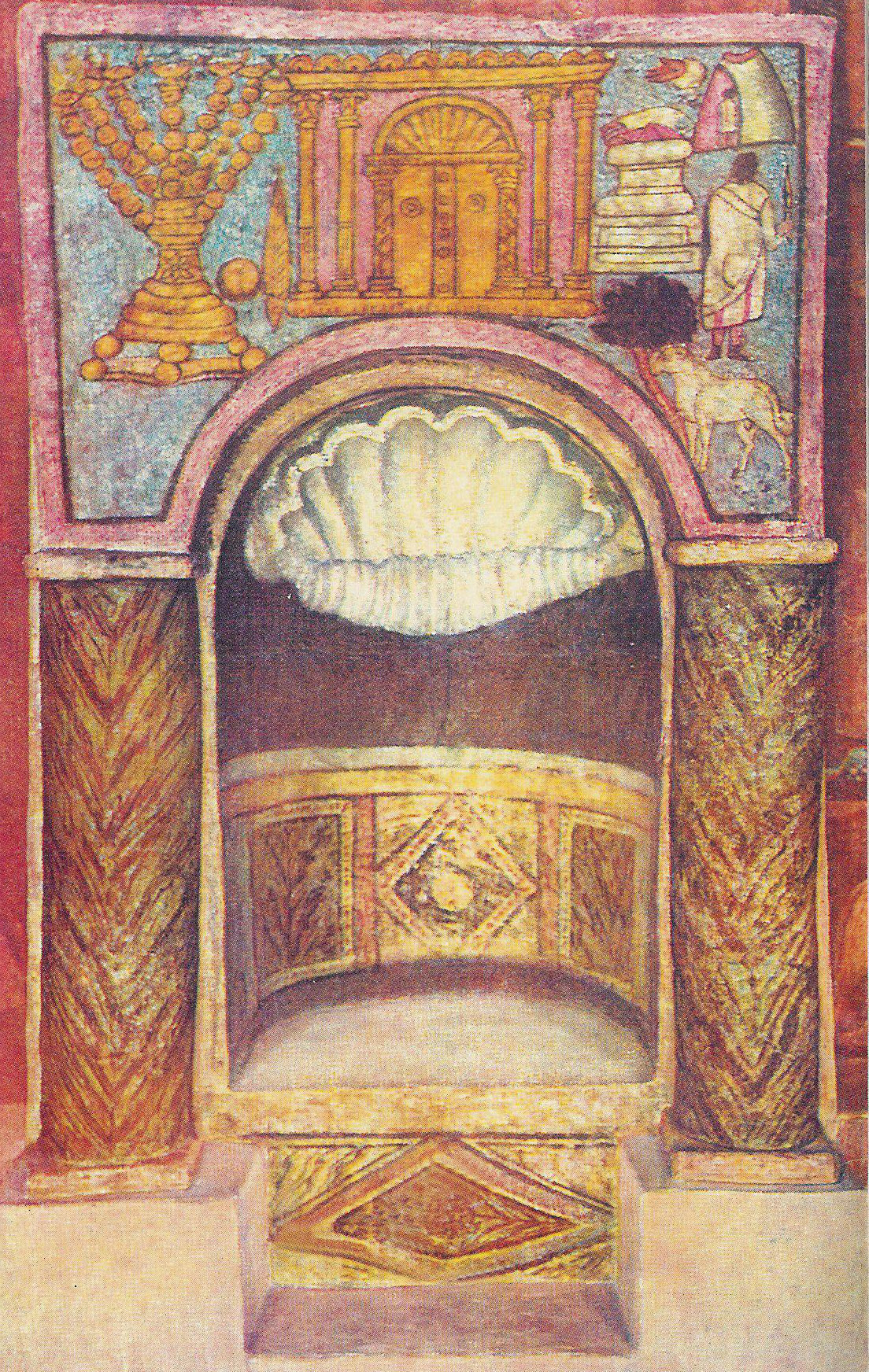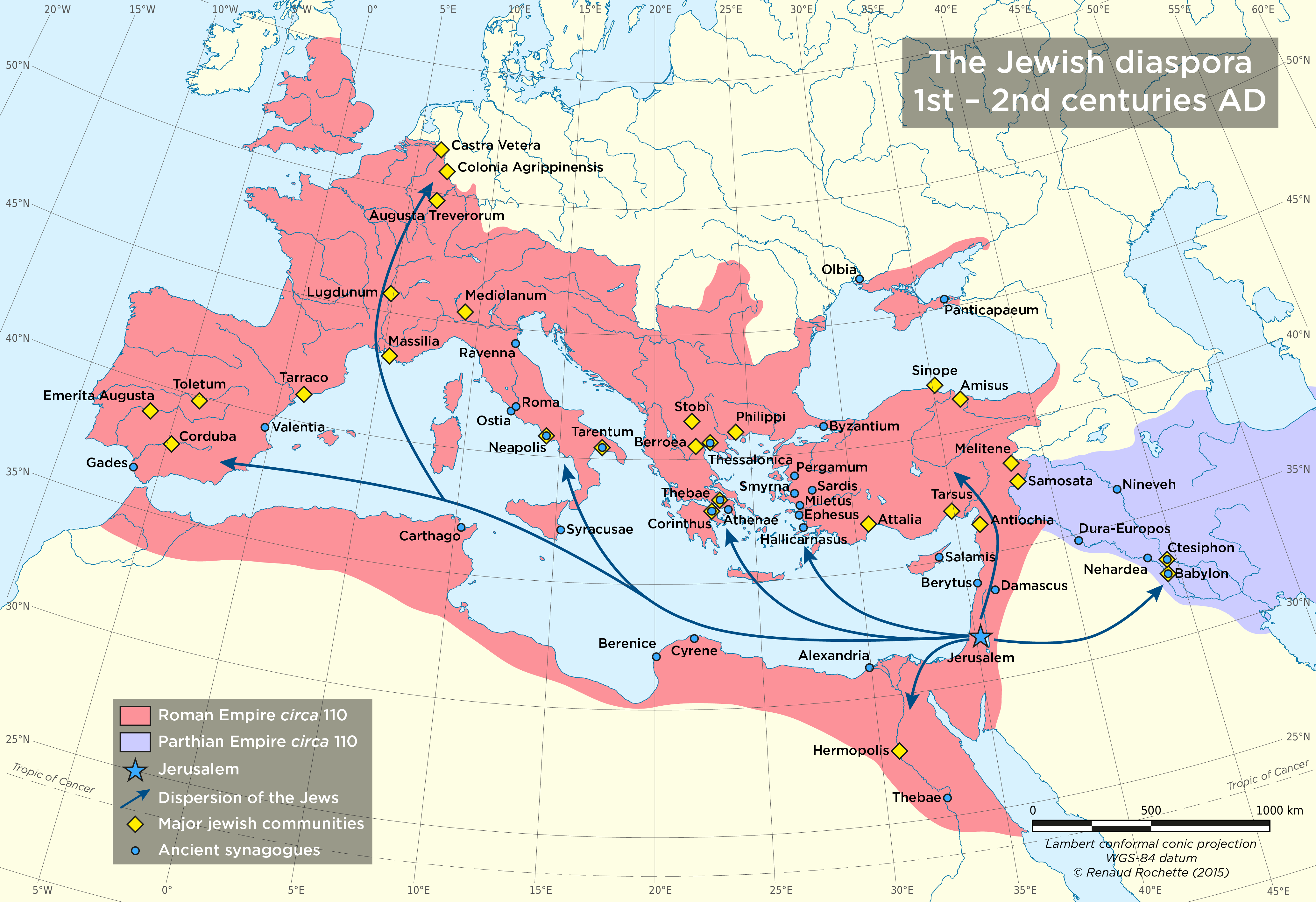2. Rabbinic Judaism
Despite the destruction of the Temple and the period of mourning that followed, Jewish life was focused on prayer and study. Having inherited a long religious and cultural tradition, Rabbinic Judaism succeeded Pharisean Judaism by structuring itself progressively, during the period between the 2nd and 4th century AD, and establishing the norm in Judaism.
Triumphal procession, detail of the Arch of Titus, 81 AD, Rome.
This triumphal arch was erected by the emperor Domitian in 81 AD and commemorates the victories of his brother and predecessor Titus in Judah, especially the destruction of Jerusalem and its Temple in 70 AD. The detail shown here depicts the Roman victory. Seated on a chariot (quadriga), Titus is leading a procession carrying the spoils of victory while entering the imperial gate. The spolis include pillaged treasures from the Temple of Jerusalem, including a chandelier with seven golden arms (menorah), a biblical symbol that was located inside the Temple. This is the only known visual representation of the chandelier from that period.

Wikimedia Commons. Usable under the conditions of the
GNU Free Documentation License:.
Licensed under the Creative Commons Attribution 3.0 unported:
http://creativecommons.org/licenses/by/3.0/deed.en
Image under URL:
http://commons.wikimedia.org/wiki/File:Arch_of_Titus_Menorah.png (09/02/2015)
Cassius Dio, Roman History, Livre LXV.
Though a breach was made in the wall by means of engines, nevertheless, the capture of the place did not immediately follow even then. On the contrary, the defenders killed great numbers that tried to crowd through the opening, and they also set fire to some of the buildings near by, hoping thus to check the further progress of the Romans, even though they should gain possession of the wall. In this way they not only damaged the wall but at the same time unintentionally burned down the barrier around the sacred precinct, so that the entrance to the temple was now laid open to the Romans. 2 Nevertheless, the soldiers because of their superstition did not immediately rush in; but at last, under compulsion from Titus, they made their way inside. Then the Jews defended themselves much more vigorously than before, as if they had discovered a piece of rare good fortune in being able to fight near the temple and fall in its defence. The populace was stationed below in the court, the senators on the steps, and the priests in the sanctuary itself. 3 And though they were but a handful fighting against a far superior force, they were not conquered until a part of the temple was set on fire. Then they met death willingly, some throwing themselves on the swords of the Romans, some slaying one another, others taking their own lives, and still others leaping into the flames. And it seemed to everybody, and especially to them, that so far from being destruction, it was victory and salvation and happiness to them that they perished along with the temple.;
Cassius Dio, Roman History, Livre LXV.
http://penelope.uchicago.edu/Thayer/E/Roman/Texts/Cassius_Dio/65*.html
(09/02/2015)
Cassius Dio was a Roman historian who lived between the 2nd and 3rd centuries and who wrote in Greek. He was born in Asia Minor and came from a privileged and powerful family. He led a career as a prominent civil servant (cursus honorum) and was close to the emperors. He is known for his 80-volume Roman History, which traces the entire history of Rome, from its origins to 229 AD. His accounts are not always objective but they are a very important source for the study of Roman history.
The two excerpts included here refer to the sack of Jerusalem in 70 AD by the armies of Titus and the burning of the Temple. Dio Cassius emphasized the resistance by the Judeans and their propensity to sacrifice when defending their sanctuary. The city was completely destroyed, only the tower of David and the western war of the Temple remained. This event, which brought to an end four years of consecutive wars after the revolt of the Judeans against Rome, also triggered the second Jewish diaspora. It had important religious consequences that led to the destruction of the main place of worship, creating a real ideological and liturgical challenge for the Jews.
Tympanum of the Dura-Europos synagogue (2nd-3rd centuries)
The synagogue of Dura-Europos, which today is located in Syria, was part of the ancient Hellenistic and Roman province. According to the information we have today, the structure has been known since the 3rd century, but it probably replaced an older building. Discovered in 1920, it depicts a group of previously unseen figurative frescoes of an ancient synagogue. They are now part of the collection of the National Museum of Damascus.
This is the niche of the holy arch from the Western wall of the synagogue, oriented towards Jerusalem. Its purpose was to house the scrolls of the Torah. The middle of the tympanum is embellished with a visual representation of the Temple of Jerusalem, which housed the Ark of the Covenant until its destruction. It can be understood both as a visual representation of a wish to commemorate the destroyed sanctuary, the eternity of Judaism and the hope for a national renaissance.
To the left of the Temple, there is a chandelier with seven arms (menorah), a biblical symbol from the holy text in the Tabernacle of Moses, from Solomon’s Temple. The visual representation of the menorah is a recurrent motif in the synagogues of the diaspora. There are also two other symbolic Jewish elements: a palm tree branch (lulav) and a citrus fruit (etrog) referring to the feast of Sukkot (or the feast of tabernacles), a reference to the consecration Salomon’s Temple.
On the other side, to the right of the Temple, there is a visual representation of the biblical story of the binding of Isaac, which, according to the narrative, took place on Mount Moriah. This is the oldest visual representation of this well-known biblical story. We see Abraham’s back facing the altar on which he is clutching his son Isaac while holding with his right hand a knife for making the sacrifice. But, God’s hand, on the upper part of the fresco, stops Abraham’s hand. Below there is a ram tied to a tree that Abraham cannot see and above there is a cone-shaped tent and a small figure which, according to the Rabbinic interpretation, is the figure of Sarah sent by Satan to help make the sacrifice.
All three scenes embellishing the tympanum are references to the Temple of Jerusalem.

Wikimedia Commons. Usable under the conditions of the GNU Free Documentation License.
Public domain
Image under URL: http://commons.wikimedia.org/wiki/File:Dura_Synagogue_ciborium.jpg
(09/02/2015)
The Jewish diaspora in the 1st – 2nd centuries
The Jewish diaspora preceded the destruction of the Temple of Jerusalem in 70 since it dates back to the Babylonian exile and the destruction of the First Temple in the 6th century BCE. In the second Jewish diaspora, the Jerusalem and its Temple took place, as well as massive waves of departure of Jews from the province of Palestine toward the Roman Empire. But the separation of Jews from their spiritual centre did not create a rupture with their religious beliefs and traditions. The “dispersion” of Jews prompted the development of multiple Jewish communities throughout the world, which led to the creation of a very diversified Jewish culture.

Author: Renaud Rochette. Lambert conformal conic projection
Standard parallels: 20°N and 60°N. Standard meridian: 20°E WGS-84 datum.
Data: http://www.naturalearthdata.com
Hydrography (coastline, lakes and rivers): NaturalEarth (public domain)
This work is licensed under a Creative Commons Attribution-NonCommercial-NoDerivatives 4.0 International License.






